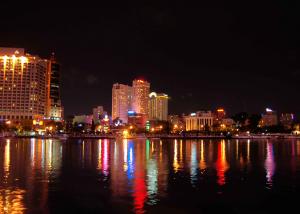HCM City Water Supply Endangered by Pollution

Sai Gon River in ${bigcity_Ho_Chi_Minh_City:”Ho Chi Minh City”} has suffered pollution due to industrialization. And over the years, the pollution has gotten worse that the city’s main water supply is in danger.
Sai Gon River runs through 40 industrial parks in Binh Duon, Binh Phuoc, Tay Ninh provinces and Ho Chi Minh City itself. But only 21 of these parks have an industrial waste treatment system, one of the main factors of the pollution. Moreover, most of the treated water released from these facilities fall short ofthe official requirements set by the environmental authorities.
But this is not all there is. Sai Gon River is also polluted by industrial and agricultural waste water from small-sized enterprises operating along the river which is equivalent to 65,000 cubic meters a day. Residential waste is another pollution factor. Everyday, 748,000 cubic meters of waste water is dumped into the river from residential areas in localities, with over 90% of the waste coming from Ho Chi Minh City. That is equivalent to only less than 20% of household waste collected and treated due to the limited number of waster water treatment plants, the rest is discharged into the river.
According to a study conducted by the Institute for Water and Environmental Technology, a regular test done on Sai Gon River revealed a pollution level many times over the Vietnamese standard level of pollution. The pollution is particularly concentrated in Ho Chi Minh City. Binh Hung Waste Water Treatment Factory in Binh Chanh District is the only treatment plant built along the river, and it is
designed to treat only 141,000 cubic meters of waste water everyday.
The neighboring province Binh Duong is suffering the same fate because of the presence of many production businesses. There are more than 5,000 production factories in the province with less than 20% passing the environmental regulations. In fact, last year alone, the Environment Protection Bureau fined 555 enterprises a total of VND12.6 billion (US$583,000) for violation of environmental standards.
Test results show that pollution in the province is even increasing. The establishment of an agency that will take care of Sai Gon River is being proposed, with members to be coming from personnel from related provinces, Ho Chi Minh City’s People’s Committee and representatives from the Ministry of Natural Resources and Environment. Their primary function would be to conduct water tests and inspections on Sai Gon River.
Projects dedicated solely at solving the pollution at Sai Gon River are also being considered. 13 major projects worth VND1.7 trillion ($82 million) will be implemented from 2011 to 2015 aimed at treating water at industrial parks and dredge canals.
Unless quick and serious measures are implemented to solve the grave water pollution at Sai Gon River, the river could die, causing more damage to the natural and economic sectors of the area.









